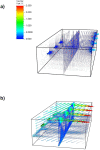Turn Up the Lights, Leave them On and Shine them All Around-Numerical Simulations Point the Way to more Efficient Use of Far-UVC Lights for the Inactivation of Airborne Coronavirus
- PMID: 34599612
- PMCID: PMC8661964
- DOI: 10.1111/php.13523
Turn Up the Lights, Leave them On and Shine them All Around-Numerical Simulations Point the Way to more Efficient Use of Far-UVC Lights for the Inactivation of Airborne Coronavirus
Abstract
It has been demonstrated in laboratory environments that ultraviolet-C (UVC) light is effective at inactivating airborne viruses. However, due to multiple parameters, it cannot be assumed that the air inside a room will be efficiently disinfected by commercial germicidal ultraviolet (GUV) systems. This research utilizes numerical simulations of airflow, viral spread, inactivation by UVC and removal by mechanical ventilation in a typical classroom. The viral load in the classroom is compared for conventional upper-room GUV and the emerging "Far-UVC." In our simulated environment, GUV is shown to be effective in both well and poorly ventilated rooms, with greatest benefit in the latter. At current exposure limits, 18 commercial Far-UVC systems were as effective at reducing viral load as a single upper-room GUV. Improvements in Far-UVC irradiation distribution and recently proposed increases to exposure limits would dramatically increase the efficacy of Far-UVC devices. Modifications to current Far-UVC devices, which would improve their real-world efficacy, could be implemented now without requiring legislative change. The prospect of increased safety limits coupled with our suggested technological modifications could usher in a new era of safe and rapid whole room air disinfection in occupied indoor spaces.
© 2021 American Society for Photobiology.
Figures









Similar articles
-
UV Inactivation of SARS-CoV-2 across the UVC Spectrum: KrCl* Excimer, Mercury-Vapor, and Light-Emitting-Diode (LED) Sources.Appl Environ Microbiol. 2021 Oct 28;87(22):e0153221. doi: 10.1128/AEM.01532-21. Epub 2021 Sep 8. Appl Environ Microbiol. 2021. PMID: 34495736 Free PMC article.
-
Far-UVC light (222 nm) efficiently and safely inactivates airborne human coronaviruses.Sci Rep. 2020 Jun 24;10(1):10285. doi: 10.1038/s41598-020-67211-2. Sci Rep. 2020. PMID: 32581288 Free PMC article.
-
Virucidal Efficacy of Blue LED and Far-UVC Light Disinfection against Feline Infectious Peritonitis Virus as a Model for SARS-CoV-2.Viruses. 2021 Jul 23;13(8):1436. doi: 10.3390/v13081436. Viruses. 2021. PMID: 34452302 Free PMC article.
-
Assessing the safety of new germicidal far-UVC technologies.Photochem Photobiol. 2024 May-Jun;100(3):501-520. doi: 10.1111/php.13866. Epub 2023 Nov 6. Photochem Photobiol. 2024. PMID: 37929787 Review.
-
Air Disinfection for Airborne Infection Control with a Focus on COVID-19: Why Germicidal UV is Essential†.Photochem Photobiol. 2021 May;97(3):493-497. doi: 10.1111/php.13421. Epub 2021 Apr 5. Photochem Photobiol. 2021. PMID: 33759191 Free PMC article. Review.
Cited by
-
Far-UVC (222 nm) efficiently inactivates an airborne pathogen in a room-sized chamber.Sci Rep. 2022 Mar 23;12(1):4373. doi: 10.1038/s41598-022-08462-z. Sci Rep. 2022. PMID: 35322064 Free PMC article.
-
222 nm Far-UVC from filtered Krypton-Chloride excimer lamps does not cause eye irritation when deployed in a simulated office environment.Photochem Photobiol. 2024 Jan-Feb;100(1):137-145. doi: 10.1111/php.13805. Epub 2023 Apr 27. Photochem Photobiol. 2024. PMID: 37029739 Free PMC article.
References
-
- Kowalski, W. (2010) Ultraviolet Germicidal Irradiation Handbook: UVGI for Air and Surface Disinfection. Springer Science & Business Media.
Publication types
MeSH terms
Grants and funding
LinkOut - more resources
Full Text Sources
Medical

